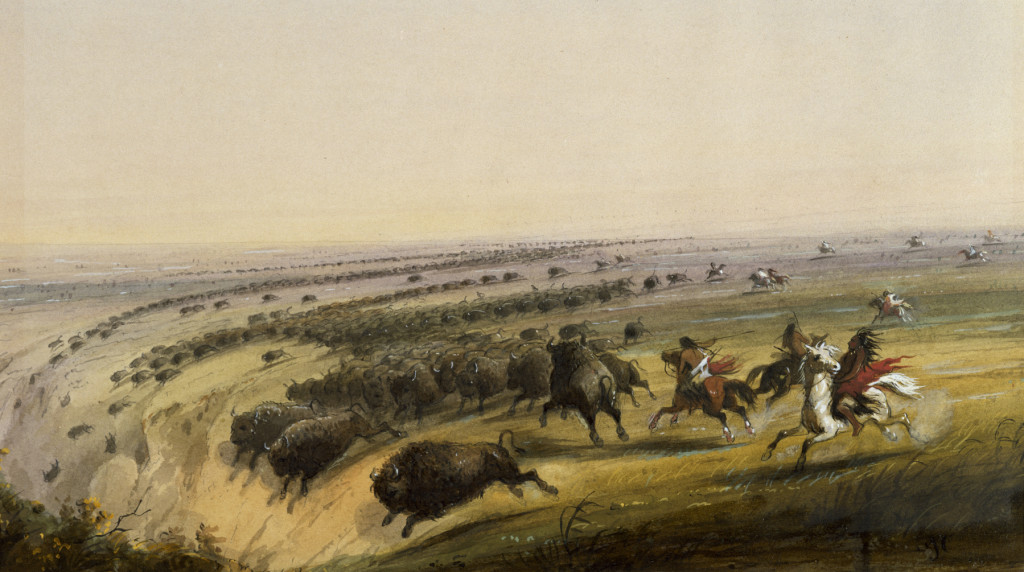There is a scene mid-way through Alejandro Iñnàritu’s The Revenant in which the brutally injured fur trapper Hugh Glass—making his way through the Great Plains in 1823—scrambles up the side of a river to find himself at a foothills where hundreds of buffalo are stampeding. Kicking up an almost magical alchemy of dust and snow, the buffalo transfix Leonardo DiCaprio’s nearly broken, starving character, who fixates on the one animal taken down by a pack of wolves not far away.
 It is one of the many moments in which the film trades the visceral brutality of its landscape for that very landscape’s overweening beauty, a visual chiasmus that speaks to The Revenant’s overall cinematic structure. Unlike Iñnàritu’s previous film Birdman (2014), located in a New York City theater whose crampedness is reflected in a vibrant and cacophonous jazz score, the Revenant is crystalline sparseness, a film the director explained is more about “painting and dreams” than the sonic energy of his previous effort.
It is one of the many moments in which the film trades the visceral brutality of its landscape for that very landscape’s overweening beauty, a visual chiasmus that speaks to The Revenant’s overall cinematic structure. Unlike Iñnàritu’s previous film Birdman (2014), located in a New York City theater whose crampedness is reflected in a vibrant and cacophonous jazz score, the Revenant is crystalline sparseness, a film the director explained is more about “painting and dreams” than the sonic energy of his previous effort.
There is something about the buffalo scene that functions like a nostalgic painted tableau from a bygone era; a vision of purity that cannot be replicated. But this moment also introduces another measure of experience that challenges a reading of the Revenant anchored solely in American literary traditions.
It’s that tradition through which the movie has primarily been read. In last week’s LARB pages, Wai Chee Dimock referenced the novels James Fenimore Cooper, noting that the film captures an aesthetic of miscegenation, a kind of “half-an-half” that turns “a derogatory term into an existential condition yielding a new visual field.” The specter of racial mixing (a fact of history as well as a lived problem the film is acutely aware of, particularly in the character of Glass’ half-Pawnee son, Hawk) permeates relationships between the dead and the living, between those who claim the land and those who merely occupy it, between what we hear and what we see.
This is particularly the case with seeing, as Dimock writes that the film dramatizes the “observational style of a bereaved eye,” the camera (especially Iñnàritu’s punctuated use of the tracking shot) darting over its objects with a haughtiness devoid of emotion or attachment.
But Iñnàritu’s naturalistic shot conjures up not only the universal dynamism of a harsh wilderness, but also the precise image of buffalo jumping, one that begins to open up the history of Iñnàritu’s film. Game jumps or buffalo jumps were largely used by the First Nations to drive plain bison off cliffs for communal hunting. Though buffalo jumping seems to have steeply declined with the introduction of horses, it is still described in the written records of 1804’s Lewis and Clark Expedition, the first to cross the western United States. Some of these sites still exist in and around Montana; yet one of the best preserved (and a UNESCO World Heritage site) is Head-Smash-In-Buffalo-Jump, located in Alberta, Canada, where the foothills meet the Rockies some 200 kilometers from Calgary.

I mention this because The Revenant is a film somewhat dogged by its filming and production costs, and a picture that, while organized around the historical figure of American trapper Hugh Glass, leans heavily on the wild beauty of the Canadian Rockies. The film’s sweeping, panoramic desire to maintain the otherness of its natural world is largely fulfilled by the untamed vistas that characterize the mountains surrounding Calgary and Squamish, in Western Canada. Hundreds of extras were additionally recruited from First Nations reserves around Southern Alberta for the extensive battle scenes and plot lines involving the numerous tribes occupying the plains.
This doesn’t seem incidental: The Revenant, I think, is less intent on projecting an American mythology onto the unrecognizability of the Canadian wilderness than drawing this landscape into the foreground, making it alive, recalcitrant, and discontinuous, perhaps in spite on itself. It thus introduces another measure of alienation to an already unforgiving set of images by calling into question its own national images.
In the film, Glass is part of an expedition hunting pelts through what is now the Dakotas. The most experienced hunter, he brings his son (Forrest Goodluck) with him (whose dead mother reappears throughout the film in dream-like flashbacks), to the chagrin of his fellow trapper John Fitzgerald (Tom Hardy), who was scalped by natives at one point in the past. The historical context for this—the fur trade in the North American interior—was one that stretched geographically from the Mississippi to Wyoming to the harsh terrain of Athabasca into New France or French Canada, whose traders feature in The Revenant largely as motley villains (the French trappers are holding the daughter of an Arikara Chief, whom Glass rescues while she is being raped).
The evolution of the fur trade subsequently rested on an uneasy trafficking between trappers and First Nation tribes, who, in the early days of this economy, were the ones largely responsible for the actual trapping and preparing of pelts, and consequently paid with alcohol to remain compliant. We find then, that the kind of rugged individualism typically read as a single outgrowth of this period in American history is more of a collage of different figures and communities.
This is notably the case for the character of the fur trapper (like Glass and Fitzgerald) himself, whose symbolic power is indebted to the legendary Canadian figure of the coureur-du-bois (“wood runner”). Coureurs, skilled explorers and ultimately illegal entrepreneurs (they traded without licenses), were chiefly responsible for driving the fur trade further inland, a perilous endeavor depicted in The Revenant. Because the scale of their notoriety eclipsed their actual numbers, coureurs were also responsible for galvanizing the mythology of the trapper as a woodsman / mountain man unbound by the laws of colonial society; the very laws that the film makes brutally clear have no function in its diegetic world.
Rather than share the glory of early wilderness masculinity in The Revenant, we are invited, I would suggest, to witness its uncanny formation as a pastiche of different sensibilities and traditions. For all of Glass’ extreme individual struggles (being mauled to an inch of his life by a bear, driven off a cliff by the Arikara, witnessing the death of his son, speechless and immobile), the film feels more like an exploration of American exceptionalism rather than a celebration of it. The haunting sign that hangs around the neck of a murdered Pawnee man who had saved Glass’s life by tending to his infected wounds and transporting him by horseback—“Nous sommes touts des sauvages”—makes that painfully clear.
 Yet the question of exceptionalism makes itself felt not only in social and political terms but also in aesthetic ones: how can the film claim one vision of survival when its very fabric—location, plot, style—overall seem to drive at its unraveling?
Yet the question of exceptionalism makes itself felt not only in social and political terms but also in aesthetic ones: how can the film claim one vision of survival when its very fabric—location, plot, style—overall seem to drive at its unraveling?
This point recalls writer Margaret Atwood’s critical appraisal of Canadian literature, Survival. Published in 1972, the volume does not continue to command the critical presence it once did, but its intellectual boldness should not be discounted. Atwood dares to argue here that Canadian literature has an overarching symbolism, that of Survival, or “La survivance.” Atwood distinguishes the central idea of Canadian survival by its “intolerable anxiety” from a more widely recognized American frontier sentiment distinguished by “excitement.” The argument, no doubt, reduces the complexity of “national literature” as an idea, one that, according to critics like Homi Babha, is always in a process of displacement and ambivalent articulation.
The latter problem, however, can be read back into The Revenant and its current critical reception: if the film puts forth some distinctly “American” cultural tropes of the rugged yet empathetic frontiersman spanning from Cooper’s The Last of the Mohicans to Sydney Pollack’s Jeremiah Johnson, it also powerfully undoes them by crafting a strange and prescient imaginary—one deeply in line with the culture and history of Canadian naturalism—that is not quite of the order of these other narratives.
Curiously, the first recorded use of the term “revenant” from the Oxford English Dictionary is from 1823, the year the film is set: “A person who returns from the dead; a reanimated corpse; a ghost.” The revenant in the film—Glass, who is buried alive by Fitzgerald only to make his way back to Fort Kiowa, the trade outpost—suggests a kind of attenuated myth of American individualism Iñnàritu has sketched out for us. The struggle to survive, of course, to continuously have to chart a new ethical paradigm for oneself and one’s relationship to the what is around us, gains a new meaning at a moment of unprecedented and sweeping climate change, when the human perspective seems in danger of muting itself for good.
Glass’ almost magnetic connection to animals (a sort of blurring of inviolable boundaries, of the careful intimacy between human and animal in the wild) is what arguably gets him into trouble in the first place: after being mauled by a mother grizzly protecting her cubs, Glass attempts to shoot at her while injured, leading to a second attack that leaves him near death and unable to speak due to a hole in his throat. Fitzgerald later stabs Glass’s son in front of him while he lies strapped into a makeshift stretcher, and the sheer agony of losing the power of speech and communication—the only human traits worth saving, it would seem—is nearly unbearable.
The question of contemporary survival in The Revenant then seems more perversely in line at times with the perspective of Fitzgerald, who desperately wants to get paid for the work he has done and the pelts he has moved, realizing finally that the system is not in anyone’s control and not designed to reward any one person. Like its visual cousin, Nic Pizzolatto’s and Cary Fukunaga’s True Detective, a deeply cinematic piece of television saturated with the magic realist, post-Katrina ruins of the Bayou, The Revenant draws on the tension between a speculative realist account of the natural world, one lacking in individual focalization and steeped in the emptiness of the Canadian wild, and an aesthetic of negative redemption—a drive to hell, in other words—that is stubbornly human in its contours.

